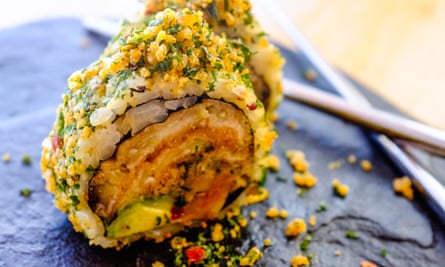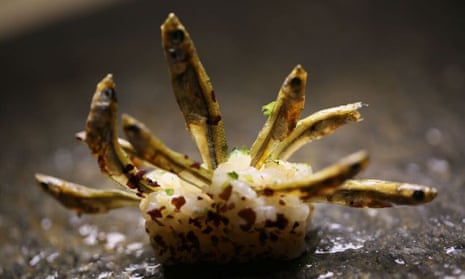Attempts to eradicate invasive species have ranged from genetic modification to unleashing a squadron of goats upon them. This growing problem now has another potential solution: fine dining.
A restaurant has opened in Miami Beach that encourages diners to tuck into invasive species – the plants and animals that have been introduced to a new area, typically causing problems for the environment and native species.
The venue, called Prey, offers up a range of delicacies including roast feral pig, lion fish and wild Texas antelope sushi. Fish ribs, made from invasive Asian carp, are seasoned in baked ginger guava. If you fancy something a little lighter, how about crickets covered in brie?
Chef Bun Lai, who conceived the pop-up eatery, catches some of the species himself, having long been concerned by the impact of invasive species.
“I’ve caught lizards and pythons and so on,” he said. “We did two years of research into Florida because this is the ground zero of invasive species in America. I spent months living out in the Everglades. We wanted a cuisine that celebrates nature – people are surrounded by walls normally, their food is so processed and shrink-wrapped.”
Lai, who made his name at another restaurant in his home state of Connecticut, said there were lines for several blocks when Prey opened in February. Convincing people to regularly tuck into antelope and crickets is another matter, however.

“You can’t make everyone happy, really,” he said. “Sometimes people have to try something seven times before they like it. If people come back they will get to like it a bit more each time. A wild lion fish tastes good – much better than a farmed fish.”
As even a casual observer of The Simpsons will know, invasive species can cause havoc. Indeed, research released by the Royal Society last month showed that “alien species” have been the second most common threat to species that have become extinct since 1500.
Whether they are introduced after hitching a ride on ships or planes, or are simply released into the wild by bored or indifferent pet owners, dozens of exotic species have taken hold in the US and aren’t like to be removed any time soon. Climate change is also opening new pathways for species, which is a concern when it comes to the expanded range of mosquitos.
These newcomers can severely disrupt the balance of ecosystems and crowd out existing species. The emerald ash borer has marched across the midwest, ruining millions of ash trees. Critical riverbank habitat in Louisiana has been ripped apart by the South American Nutria, known locally as swamp rats. Lion fish have munched their way through US marine life after being displaced from their Pacific Ocean environment.
Florida is perhaps on the front line. The state has an exotic array of invaders, such as black spiny tail iguanas and the Cuban tree frog. Burmese pythons are perhaps the most destructive, wreaking havoc upon deer, bobcat and raccoon populations after infiltrating the Everglades. Symbolic snake catching expeditions aim to highlight, if not solve, the problems.
“Wood storks have been found in the guts of those snakes, too,” said Craig Martin, chief of the Fish and Wildlife branch of aquatic invasive species. “Florida certainly has the climatic conditions for the establishment for a number of invasives. But this is a growing problem across the US and it’s driven by the fact we live in a more inter-connected world.

“The impacts are economic, environmental and to human health. There are economic assessments that have shown the costs are in the tens of billions of dollars. The first goal is prevention, prevention, prevention. But once they are here we need to have a management response.”
Of particular concern to wildlife officials is the spread of Asian carp, which are moving up the Mississippi River system, multiplying in huge numbers and hogging all of the plankton that other fish require. A key goal is to prevent them entering the Great Lakes – an electric barrier has been set up to achieve this goal. So far it has proved successful but Asian carp, like many invasive species, have a tenacity that can be hard to combat.
So could eating invasive species be part of the answer? Public appetite can certainly help influence species populations – the staggering decline of tuna is a notable example – but a sizable shift in dining attitudes would need to occur before swamp rat replaces rump steak on menus.
There are other potential problems too. If an invasive species does become a popular restaurant staple, it could provide an incentive to farm them, which could lead to more of them getting into the wild.
“There is some evidence that you can reduce populations in localized areas by eating them” said Martin. “With Asian carp, we’d certainly recommend an enhanced recreational and commercial harvest of them. It’s a delicacy in Asia. I’ve eaten it and it’s bony. But it’s good.”

Comments (…)
Sign in or create your Guardian account to join the discussion